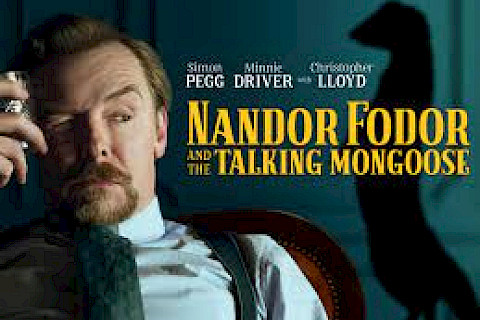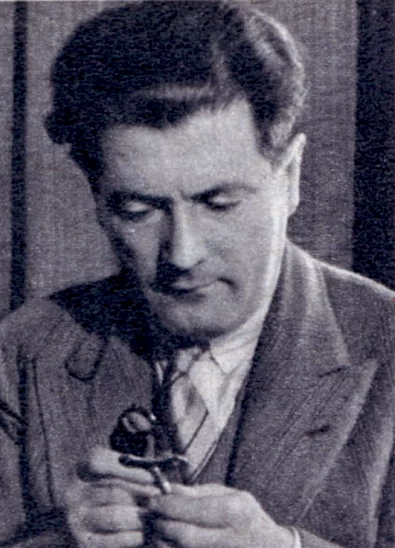

Who is Nandor Fodor?
‘Gef’ the talking mongoose is a part of paranormal legend. Most people have at least heard of the infamous talking animal. The story is about to get a lot more attention with the release of the movie ‘Nandor Fodor and the Talking Mongoose’. Simon Pegg takes the lead role of Dr Nandor Fodor, a famous paranormal psychologist, with Christopher Lloyd taking on the role of the renowned paranormal investigator Harry Price.
With the famous story relived on the big screen, some people may be asking, who is Nandor Fodor?

Born in Hungary in 1895, Fodor studied law at the Royal Hungarian University of Science, eventually earning a Ph.D. After working as a Law assistant from 1917 - 1921, his interests led him to journalism. It was around 1921 that he paid his first visit to America on the job as a reporter for the New York Hungarian-language daily Amerkai Magyar Nepszava (American Hungarian People’s Voice). It was here that his life would change direction after coming across a book at a Fourth Avenue bookshop called Modern Psychical Phenomena by Herward Carrington (1919).
“This work was a revelation to me. From then on I spent my lunch money on books, feasting on psychic knowledge in preference to the nourishing food of the Hungarian restaurants near my work.” Nandor Fodor (1959)
While he wanted to interview Carrington for his newspaper, he received an invitation from Carrington to attend a reception for famous spiritualist and Sherlock Holmes Author author Sir Arthur Conan Doyle, where he had the opportunity to interview Doyle himself. Fodor and Carrington would go on to become good friends, keeping in touch via correspondence, which was a common method of communication for this era. In 1926, Fodor interviewed Sandor Ferenczi who was a leading psychoanalyst and an associate of famous psychologist Sigmund Freud. Both Ferenczi and Fodor felt that certain pacts of psychoanalysis could tie in with psychical research and became fast friends. It would later form an influence on much of Fodor’s work.

In 1927, Fodor had his first experience with the afterlife when he attended a seance with voice medium William Cartheuser. It was here Fodor believed he made contact through direct voice communication with his father who had passed. Even though years later Fodor was suspicious of the medium, he firmly remembered his very first seance where he felt an impactful emotional connection.
With his sights set on psychical research, in 1934 after immigrating to the USA as a citizen, Fodor was appointed as a Research Officer for the International Institute for Psychical Research. The institute contained both spiritualists and non-spiritualists with the aim of sympathetic and unprejudiced investigation of psychical phenomena. Fodor continued his work by writing articles on mediums, Spiritualism and psychical research for the Bristol Evening World newspaper which were also reprinted as the book These Mysterious People (1934). This was all the while he was actively investigating mediumistic transfiguration, apports, direct voice communication, levitation, haunted and poltergeists. He would get to finally collaborate with his friend Carrington who was a Research Officer for the American Psychical Institute of New York. They produced a 44 page booklet that would turn into the book Haunted People (1951).
He went on to travel to Britain where Fodor began working with well-known psychoanalyst Dr Elizabeth Severn who had studied with under his friend Ferenczi. His interest in psychoanalysis was reignited once again and he felt that it could help potentially explain certain psychical phenomena. It was with this train of thought that he came up with theories considered to be well ahead of their time and somewhat controversial. He was criticised by many, especially spiritualists who felt the two areas were not to be mixed, mainly as psychoanalysis questioned sexual motivations.
His theories on poltergeists for example were that they are external manifestations of conflicts within a subconscious mind rather than an entity with its own mind. He felt a poltergeist was caused by a human suffering emotional stress and tension. In a case at Thornton Heath, Fodor concluded that the poltergeist activity under investigation was actually caused by the subject Mrs. Forbe’s unconscious mind stemming from repressed sexual trauma. This case and his theories would end up affecting his position as Director of Research for the International Institute for Psychical Research as his sexual theories mixed with exposing psychic frauds had been causing waves. He was eventually terminated in 1938, despite being one of the founding members.
As Fodor was not a qualified medical professional much of his work was undermined and discredited as Britain was less receptive to his theories. Fodor returned to America where he practised as a psychoanalyst in New York, reuniting with his friend Dr. Hereward Carrington. It was in the USA where they were more welcoming to Fodor’s views connecting psychoanalysis and psychical research and he felt he could properly explore without restraint and a new respect for the mediums he was investigating.
“My attitude to psychical phenomena has undergone a tremendous change since I left England. Then I was a psychical investigator, following the routine techniques. A free hand for the researcher is none for the medium. Now I am a psychologist and my attitude is exactly the opposite: a free hand for the medium, none for the researcher.
I see now psychical research has tried to be too scientific for years and has gone bankrupt as a result. Mediums do not function well if they are used as guinea-pigs. They are human beings with the same virtues and vices as the researchers themselves.”
Fodor would write 9 influential books on top of his many articles in newspapers and journals before passing away in 1964. Fodor was an honorary member of the Danish Society for Psychical Research and the Hungarian Metaphysical Society. He was a member of the New York Academy of Science, the American Psychological Association and the New York State Psychological Association. His contribution combining psychoanalysis and psychical research has shaped much of how people view the paranormal field today, especially in terms of poltergeist phenomena.
Here are some of his works available to read via Public Domain
Freud, Jung and Occultism (1971)
Freud Dictionary of Psychoanalysis (1950)
What about Gef the talking mongoose? Well, that is an article for another day.
References
https://www.encyclopedia.com/science/encyclopedias-almanacs-transcripts-and-maps/fodor-nandor-1895-1964
https://www.nytimes.com/1964/05/19/archives/nandor-fodor-69-a-psychoanalyst-author-of-theory-to-explain.html
https://psi-encyclopedia.spr.ac.uk/articles/psi-researchers
https://www.americanghostwalks.com/articles/nandor-fodor-minneapolis
https://www.abc-people.com/data/fodor/bio2.htm
Images: Public Domain
If you enjoy LLIFS, consider buying me a book (otherwise known as buy me a coffee but I don't drink coffee and I LOVE books). Your donation helps to fund the LLIFS website so everyone can continue to access great paranormal content and resources for FREE!

Top pages with similar subjects
Don't forget to follow the Facebook page for regular updates
Join the mailing list to receive weekly updates of NEW articles. Never miss an article again!
Buy the latest and past issues Haunted Magazine
Check out the books written by LLIFS